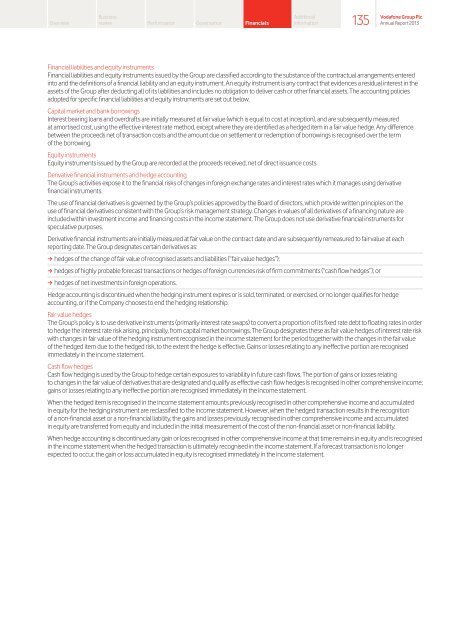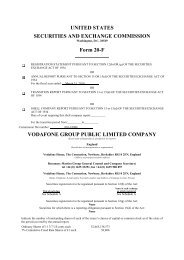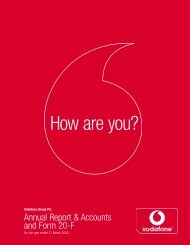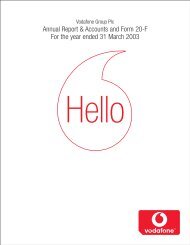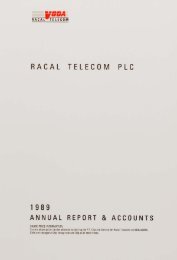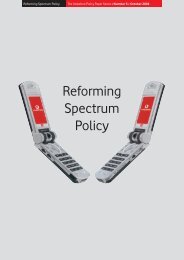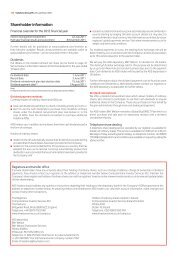The way ahead? - Vodafone
The way ahead? - Vodafone
The way ahead? - Vodafone
You also want an ePaper? Increase the reach of your titles
YUMPU automatically turns print PDFs into web optimized ePapers that Google loves.
Overview<br />
Business<br />
review Performance Governance Financials<br />
Additional<br />
information<br />
Financial liabilities and equity instruments<br />
Financial liabilities and equity instruments issued by the Group are classified according to the substance of the contractual arrangements entered<br />
into and the definitions of a financial liability and an equity instrument. An equity instrument is any contract that evidences a residual interest in the<br />
assets of the Group after deducting all of its liabilities and includes no obligation to deliver cash or other financial assets. <strong>The</strong> accounting policies<br />
adopted for specific financial liabilities and equity instruments are set out below.<br />
Capital market and bank borrowings<br />
Interest bearing loans and overdrafts are initially measured at fair value (which is equal to cost at inception), and are subsequently measured<br />
at amortised cost, using the effective interest rate method, except where they are identified as a hedged item in a fair value hedge. Any difference<br />
between the proceeds net of transaction costs and the amount due on settlement or redemption of borrowings is recognised over the term<br />
of the borrowing.<br />
Equity instruments<br />
Equity instruments issued by the Group are recorded at the proceeds received, net of direct issuance costs.<br />
Derivative financial instruments and hedge accounting<br />
<strong>The</strong> Group’s activities expose it to the financial risks of changes in foreign exchange rates and interest rates which it manages using derivative<br />
financial instruments.<br />
<strong>The</strong> use of financial derivatives is governed by the Group’s policies approved by the Board of directors, which provide written principles on the<br />
use of financial derivatives consistent with the Group’s risk management strategy. Changes in values of all derivatives of a financing nature are<br />
included within investment income and financing costs in the income statement. <strong>The</strong> Group does not use derivative financial instruments for<br />
speculative purposes.<br />
Derivative financial instruments are initially measured at fair value on the contract date and are subsequently remeasured to fair value at each<br />
reporting date. <strong>The</strong> Group designates certain derivatives as:<br />
a hedges of the change of fair value of recognised assets and liabilities (“fair value hedges”);<br />
a hedges of highly probable forecast transactions or hedges of foreign currencies risk of firm commitments (“cash flow hedges”); or<br />
a hedges of net investments in foreign operations.<br />
Hedge accounting is discontinued when the hedging instrument expires or is sold, terminated, or exercised, or no longer qualifies for hedge<br />
accounting, or if the Company chooses to end the hedging relationship.<br />
Fair value hedges<br />
<strong>The</strong> Group’s policy is to use derivative instruments (primarily interest rate swaps) to convert a proportion of its fixed rate debt to floating rates in order<br />
to hedge the interest rate risk arising, principally, from capital market borrowings. <strong>The</strong> Group designates these as fair value hedges of interest rate risk<br />
with changes in fair value of the hedging instrument recognised in the income statement for the period together with the changes in the fair value<br />
of the hedged item due to the hedged risk, to the extent the hedge is effective. Gains or losses relating to any ineffective portion are recognised<br />
immediately in the income statement.<br />
Cash flow hedges<br />
Cash flow hedging is used by the Group to hedge certain exposures to variability in future cash flows. <strong>The</strong> portion of gains or losses relating<br />
to changes in the fair value of derivatives that are designated and qualify as effective cash flow hedges is recognised in other comprehensive income;<br />
gains or losses relating to any ineffective portion are recognised immediately in the income statement.<br />
When the hedged item is recognised in the income statement amounts previously recognised in other comprehensive income and accumulated<br />
in equity for the hedging instrument are reclassified to the income statement. However, when the hedged transaction results in the recognition<br />
of a non-financial asset or a non-financial liability, the gains and losses previously recognised in other comprehensive income and accumulated<br />
in equity are transferred from equity and included in the initial measurement of the cost of the non-financial asset or non-financial liability.<br />
When hedge accounting is discontinued any gain or loss recognised in other comprehensive income at that time remains in equity and is recognised<br />
in the income statement when the hedged transaction is ultimately recognised in the income statement. If a forecast transaction is no longer<br />
expected to occur, the gain or loss accumulated in equity is recognised immediately in the income statement.<br />
135<br />
<strong>Vodafone</strong> Group Plc<br />
Annual Report 2013


